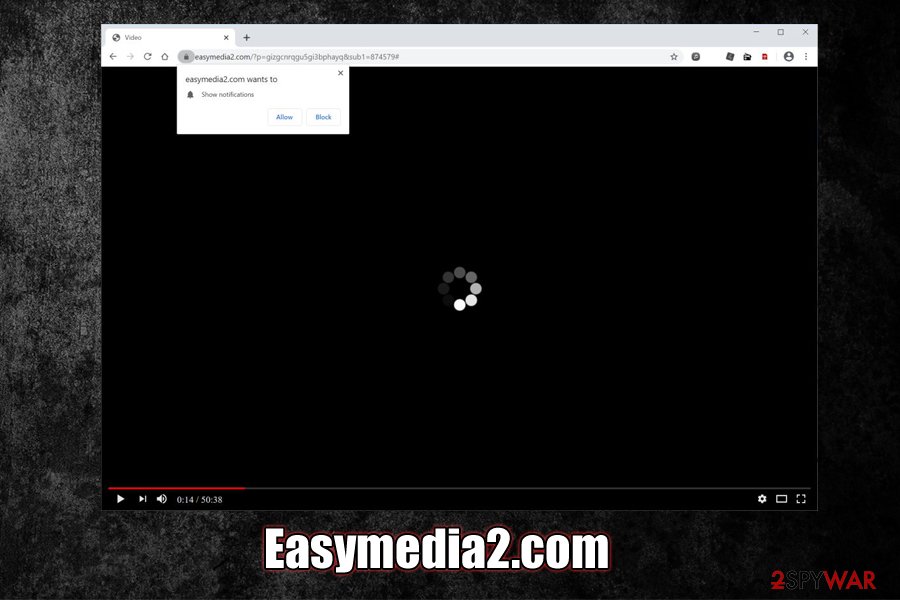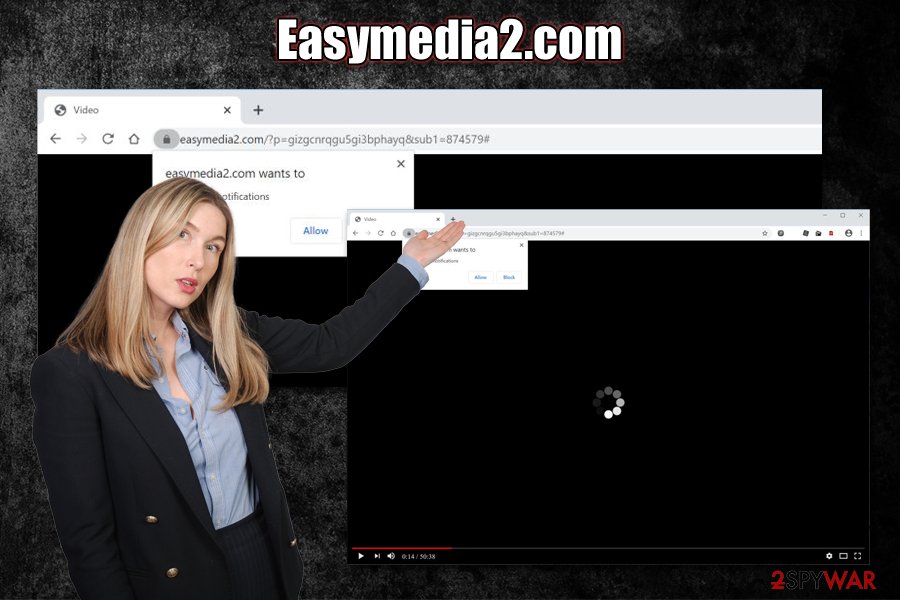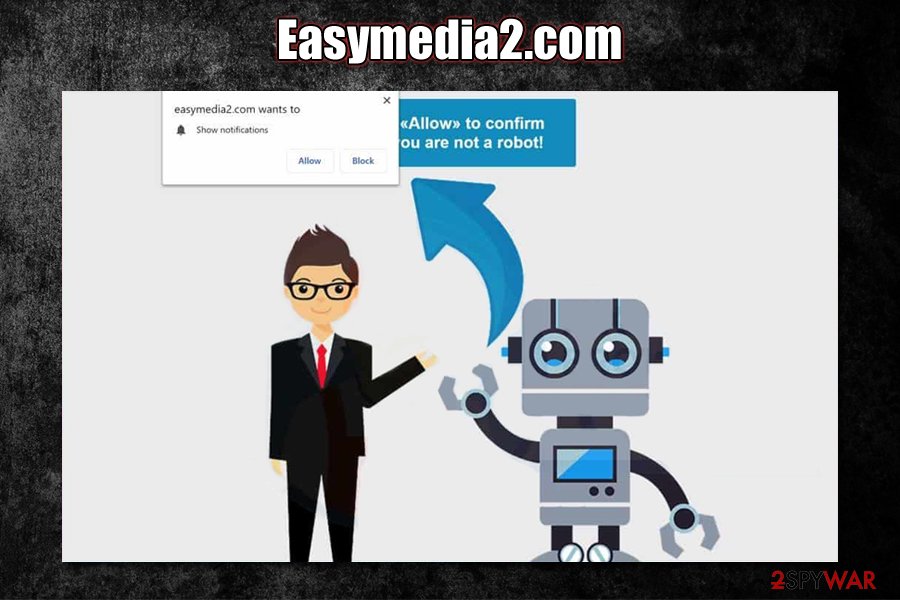Easymedia2.com is a malicious website that abuses legitimate browser feature to insert intrusive ads into users’ web browsers

Easymedia2.com is a deceptive website that uses social engineering in order to make users subscribe for its notifications
Easymedia2.com is a push notification virus that gets injected via the notification feature available on Google Chrome, Mozilla Firefox, Safari, MS Edge, and other web browsers. Upon entering the website, users are shown a pop-up message that asks whether they want to allow notifications to be displayed, all while they see a carefully compiled scam message in the background that actively prompts users to the press “Allow.”
If they subscribe to Easymedia2.com notifications, they will start receiving intrusive pop-up ads directly on their desktops. Unfortunately, these advertisements are far from being safe, as users will be constantly exposed to scam messages, click-bait, get-rich-quick, and similar links. While those who refrain from clicking on the pop-ups will be safe, getting rid of these annoying pop-ups proved to be difficult for many users, as they are unaware that they can remove Easymedia2.com via the web browser settings.
| Name | Easymedia2.com |
|---|---|
| Type | Push notification virus, adware |
| Infiltration | Redirects to malicious websites are often caused by adware – potentially unwanted program that is typically installed along with freeware obtained from third-party sites; nevertheless, desktop notifications from Easymedia2.com are allowed via the browser push notification feature |
| Risks | Installation of potentially unwanted software or malware, information disclosure, or monetary loss due to frequently encountered online scams, etc. |
| Symptoms | Those who press “Allow” upon entering the site will receive pop-ups directly on their desktop on a regular basis – these links will direct users to scam, phishing, and similar unsafe sites; Nevertheless, adware might also be present on the computer if redirects to suspicious websites and intrusive ads are commonly encountered during web browsing sessions |
| Termination | To get rid of the Easymedia2.com spam notifications, you should access web browser settings and terminate the website from the “allowed” list; the root cause of pop-ups and other types of advertisements might be adware – in such case, scan your machine with anti-malware or follow manual removal instructions we provide |
| Recovery & optimization | In case your computer is lagging, hanging, showing error messages, and having other issues after you get rid of adware or malware, scan it with a repair tool Reimage Reimage Cleaner |
The motivation of Easymedia2.com authors is simple – to make users click on links that are mostly unsafe and earn ad revenue in the process. There have been thousands of such sites created regularly – good examples include Twok.pro, Cloud1.pw, Zahkit.pro, and many others. It is also important to note that these websites are often shut down due to scam activities, but thousands more are created under different names.
As evident, there are not many who would agree to receive intrusive offers and scam messages being delivered directly to their screens while using the computer or phone. Thus, crooks came up with an elaborate scheme – abusing a legitimate, built-in push notification feature to push malicious links. For that, social engineering tricks are used in order to make users click on the “Allow” button. Here’s one of the examples that Easymedia2.com virus may use to persuade visitors:
Click Allow if you are not a robot
As evident, this statement is very familiar, as users are often asked to click on a tick box or prove otherwise that they are not bots – this is a legitimate tactic to prevent malicious scripts from flooding the website. Because it is so familiar, users might believe that Easymedia2.com prompt is reasonable, and press “Allow.”
Other social engineering techniques that malicious actors behind Easymedia2.com virus use include showing a fake YouTube video that is allegedly is about to be played, or asking users to press allow if they are 18+, which immediately implies that content of sexual nature would be displayed. However, Easymedia2.com will not disclose anything beyond what is already shown on the site, as it is simply not designed to do so – the goal is to make a visitor click on the “Allow” button.

Easymedia2.com is a push notification virus that delivers malicious ads directly into users’ desktops
Unfortunately, the reason why you might have been redirected to the Easymedia2.com site is due to adware that might be hiding inside your Windows or macOS computer, as well as iPhone or Android device (note that notifications can be enabled on all type of devices as well, including phones). These potentially unwanted programs are designed to display users’ advertisements and redirect to affiliated websites.
The trick is that adware developers often pick untrustworthy ad networks that might direct users to malicious sites, such as Easymedia2.com. Other adware infection symptom includes:
- Startup page, new tab URL and the search engine of the web browser is set to a different address;
- Intrusive advertisements show up on all visited websites;
- All searchers are directed to another provider (sometimes it might be legitimate, such as Yahoo or Google);
- Search results are filled with sponsored links;
- Browser extensions or applications installed without permission.
Additionally, adware is often set to gather browsing-related information about users with the help of web beacons, Flash cookies,[1] and other tracking technologies. The data collected helps monetization, as it allows expose users to targeted ads.[2]
In the case of the adware infection, Easymedia2.com removal from web browsers will not be enough, as you will have find and eliminated the potentially unwanted application from your device. To do that, you can rely on the manual removal guide provided below or scan your machine with anti-malware. Additionally, experts[3] recommend resetting all the installed browsers and using Reimage Reimage Cleaner to repair system damage after a virus infection.
Watch out for social engineering tricks and avoid adware by paying close attention to the installation process of free apps
Push notification spam is a simple technique that utilizes an otherwise-useful browser feature and social engineering in order to deliver users advertisements. Because of the push notification feature abuse, Mozilla Firefox already announced that it would not display the prompt upon a website entry, and Google is about to follow this great example.[4] This will reduce the chance of users subscribing to websites that are malicious.
If you are not using Mozilla Firefox, however, you should learn to recognize deception online. In case of push notification scam, you should only press “Allow” on websites that you trust, and not those that you accidental got redirected to. In any case, all the promises of displaying the underlying content are fake – there is nothing to be seen.

Easymedia2.com uses social engineering and familiar features like “Confirm you are not a robot” in order to make users subscribe to unwanted advertisements
Another way to protect yourself from unwanted ads is making sure that you dot install adware or other potentially unwanted programs on your machine – they are typically installed behind users’ back with the help of software bundle packages distributed via third-party freeware sites. Typically, distributors employ various tricks for users not to notice optional components inside the installer, which results in users not spotting adware’s point of entry.
To avoid PUPs, you should pay a great deal of attention when installing freeware apps (generally, you should stick to official sources like Google Play, Apple Store, Amazon, etc., when possible) – always check for pre-ticked boxes, fine print text, deceptive button placements, misleading offers, and, most importantly, always opt for Advanced/Custom settings.
Get rid of Easymedia2.com desktop notifications and check your computer for adware
If the cause of intrusive advertisements is the enabled notifications via the web browser, Easymedia2.com removal should be really simple. However, many other factors come into play, including whether you click on malicious links provided by the site, whether you installed anything, and if your computer was infected with adware, to begin with.
Because each situation is different depending on system configuration and the factors mentioned above, we would like to suggest you remove Easymedia2.com virus via the web browser settings first. Here’s how to it various web browsers:
Google Chrome
- Go to Menu and select Settings
- Click Advanced
- Under Privacy and security, select Site Settings
- Pick Notifications
- Easymedia2.com should be present in the Allow section
- Select More Actions and pick Block
Mozilla Firefox:
- Go to Menu and pick Options
- Click on Privacy & Security > Notifications
- Go to Settings and find the Easymedia2.com entry
- Click on the the drop-down menu and pick Block
- Select Save Changes
MS Edge:
- Go to More and choose Settings
- Pick View advanced settings and then select Advanced
- Go to Manage permissions
- Find Easymedia2.com and turn off notifications
After that, we suggest you check your machine for adware – follow the instructions provided below to do that manually or scan the computer with anti-malware software. In case your web browser settings are set to something unexpected – you should reset web browser settings as well.
You may remove virus damage with a help of Reimage Reimage Cleaner . SpyHunter 5Combo Cleaner and Malwarebytes are recommended to detect potentially unwanted programs and viruses with all their files and registry entries that are related to them.

